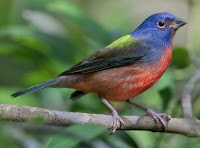PAINTED BUNTING
PAINTED BUNTING – (Passerina ciris) – (See images below)
DESCRIPTION: The Painted Bunting breeding male has a blue head and nape, lime green back, black wings and strawberry red under parts. It has a red eye ring. Eyes are black. Conical bill is grey, legs and feet are pinkish grey. Wings have some purple, then green and deep purple colors. Female has mostly faded green top and throat, with greyish under parts. Wings and tail are grey. Juvenile is similar to female. Bird length is about 12 cm (5 inches). There are two subspecies.
VOICE: https://www.xeno-canto.org/species/Passerina-ciris
NAME: ‘Bunting’ has an obscure origin and is given to several sparrow-like birds (Choate). ‘Painted’ refers to the breeding male colourful plumage. Sometimes called ‘Nonpareil’ (unrivalled) for the same reason. Latin genus name ‘Passerina’ means ‘sparrow-like’. Latin species name ‘ciris’ is the name of a bird in Greek mythology.
HABITAT: Semi-open areas such as forest edges, shrub land, parks, undergrowth.
DIET: Seeds, insects foraged mainly on the ground.
NESTING: Nest located near the ground in a tree or dense bush. Three or four light blue eggs are laid, incubated by female, who also feeds the young. Nest often parasitized by Brown-headed Cowbird.
DISTRIBUTION: Breeding range includes Texas and surrounding areas, and the southeast coast of USA. Wintering grounds cover most of Mexico (except central mountains), Florida, the Caribbean and part of Central America.
Distribution Map: https://en.wikipedia.org/wiki/Painted_bunting – /media/File:Passerina_ciris_distribution
ON PEI: Does not breed on Prince Edward Island, sightings listed as ‘accidental’ so far, in the spring. See note below on bird vagrancy.
CONSERVATION: Numbers have declined steadily over last few decades. One factor would be loss of habitat to development, another the illegal pet trade. Species is nonetheless currently not considered at risk.
NOTES: Male is one of the most colourful birds in the USA.
Vagrancy: In biology this means an animal going way outside its normal range. For birds, this can happen when there are storms and they get blown off course. On other times, the bird simply wanders in a different direction than usual. Here’s an article about vagrancy in birds.
SIMILAR SPECIES: Indigo Bunting (female)
REFERENCES: http://www.nhptv.org/natureworks/paintedbunting.htm (New Hampshire PBS)
https://www.audubon.org/field-guide/bird/painted-bunting
American Bird Conservancy (Painted Bunting)
https://nature.mdc.mo.gov/discover-nature/field-guide/painted-bunting (Missouri Department of Conservation)
http://fieldguide.mt.gov/speciesDetail.aspx?elcode=ABPBX64060 (Montana Field Guide)
https://animaldiversity.org/accounts/Passerina_ciris/ (University of Michigan)
https://txtbba.tamu.edu/species-accounts/painted-bunting/ (Texas Breeding Bird Atlas)
https://www.allaboutbirds.org/guide/Painted_Bunting/lifehistory
http://identify.whatbird.com/obj/206/overview/Painted_Bunting.aspx
https://www.tn.gov/twra/wildlife/birds/grassland-and-shrub-birds/painted-bunting.html (Tennessee Wildlife Resources Agency)
DESCRIPTION: The Painted Bunting breeding male has a blue head and nape, lime green back, black wings and strawberry red under parts. It has a red eye ring. Eyes are black. Conical bill is grey, legs and feet are pinkish grey. Wings have some purple, then green and deep purple colors. Female has mostly faded green top and throat, with greyish under parts. Wings and tail are grey. Juvenile is similar to female. Bird length is about 12 cm (5 inches). There are two subspecies.
VOICE: https://www.xeno-canto.org/species/Passerina-ciris
NAME: ‘Bunting’ has an obscure origin and is given to several sparrow-like birds (Choate). ‘Painted’ refers to the breeding male colourful plumage. Sometimes called ‘Nonpareil’ (unrivalled) for the same reason. Latin genus name ‘Passerina’ means ‘sparrow-like’. Latin species name ‘ciris’ is the name of a bird in Greek mythology.
HABITAT: Semi-open areas such as forest edges, shrub land, parks, undergrowth.
DIET: Seeds, insects foraged mainly on the ground.
NESTING: Nest located near the ground in a tree or dense bush. Three or four light blue eggs are laid, incubated by female, who also feeds the young. Nest often parasitized by Brown-headed Cowbird.
DISTRIBUTION: Breeding range includes Texas and surrounding areas, and the southeast coast of USA. Wintering grounds cover most of Mexico (except central mountains), Florida, the Caribbean and part of Central America.
Distribution Map: https://en.wikipedia.org/wiki/Painted_bunting – /media/File:Passerina_ciris_distribution
ON PEI: Does not breed on Prince Edward Island, sightings listed as ‘accidental’ so far, in the spring. See note below on bird vagrancy.
CONSERVATION: Numbers have declined steadily over last few decades. One factor would be loss of habitat to development, another the illegal pet trade. Species is nonetheless currently not considered at risk.
NOTES: Male is one of the most colourful birds in the USA.
Vagrancy: In biology this means an animal going way outside its normal range. For birds, this can happen when there are storms and they get blown off course. On other times, the bird simply wanders in a different direction than usual. Here’s an article about vagrancy in birds.
SIMILAR SPECIES: Indigo Bunting (female)
REFERENCES: http://www.nhptv.org/natureworks/paintedbunting.htm (New Hampshire PBS)
https://www.audubon.org/field-guide/bird/painted-bunting
American Bird Conservancy (Painted Bunting)
https://nature.mdc.mo.gov/discover-nature/field-guide/painted-bunting (Missouri Department of Conservation)
http://fieldguide.mt.gov/speciesDetail.aspx?elcode=ABPBX64060 (Montana Field Guide)
https://animaldiversity.org/accounts/Passerina_ciris/ (University of Michigan)
https://txtbba.tamu.edu/species-accounts/painted-bunting/ (Texas Breeding Bird Atlas)
https://www.allaboutbirds.org/guide/Painted_Bunting/lifehistory
http://identify.whatbird.com/obj/206/overview/Painted_Bunting.aspx
https://www.tn.gov/twra/wildlife/birds/grassland-and-shrub-birds/painted-bunting.html (Tennessee Wildlife Resources Agency)
 |
| Painted bunting male, by Doug Janson |
 |
| Painted bunting male, by Dan Pancamo |
 |
| Painted bunting female, by Dan Pancamo |